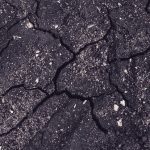Complete Guide to Wreck Alley in San Diego
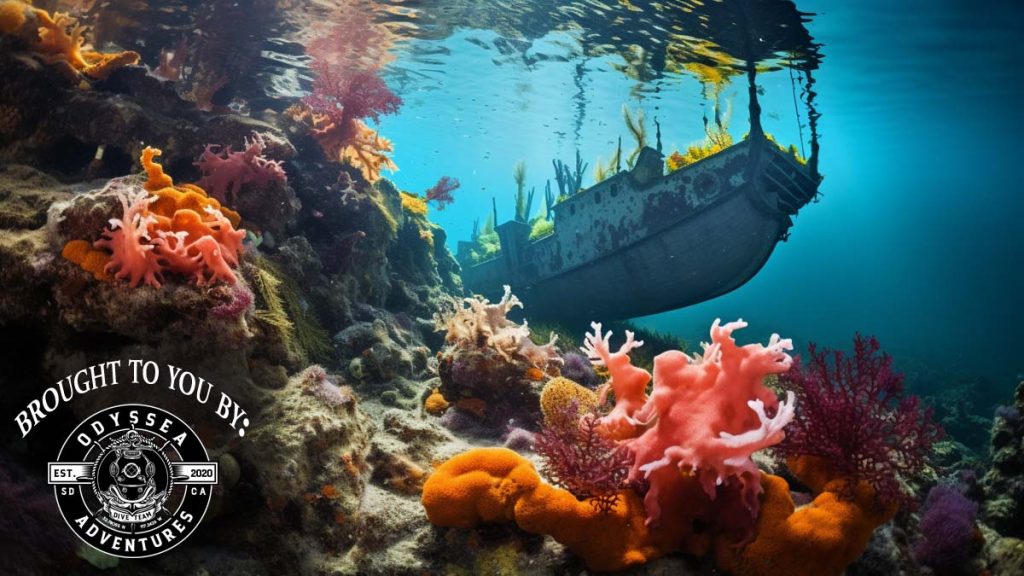
Neon sea anemones clinging to a decades-old battleship. Citrus-bright Garibaldi fish darting out from buried barges. Explosive marine diversity and eerily alluring landscapes sculpted from intentional wreckage. These are just a few surprising sights you can anticipate when you dive into Wreck Alley San Diego. Just a few short miles off the coast of Mission Beach, Wreck Alley is a mecca for marine life and underwater adventurers of all experience levels. If you’re craving a truly remarkable aquatic escapade, you’ve gotta keep reading this in-depth guide to exploring Wreck Alley in San Diego.
Table of Contents
- Diving Deep into Wreck Alley in San Diego
- What is Wreck Alley in San Diego?
- History of Wreck Alley
- Key Attractions in Wreck Alley
- How Deep is Wreck Alley in San Diego?
- Diving in Wreck Alley
- How to Prepare for a Dive in Wreck Alley
- When is Wreck Alley Open?
- About Conservation and Preservation Efforts at Wreck Alley
- Other Activities Near Wreck Alley in San Diego
- Ready, Set, Dive!
Diving Deep into Wreck Alley in San Diego
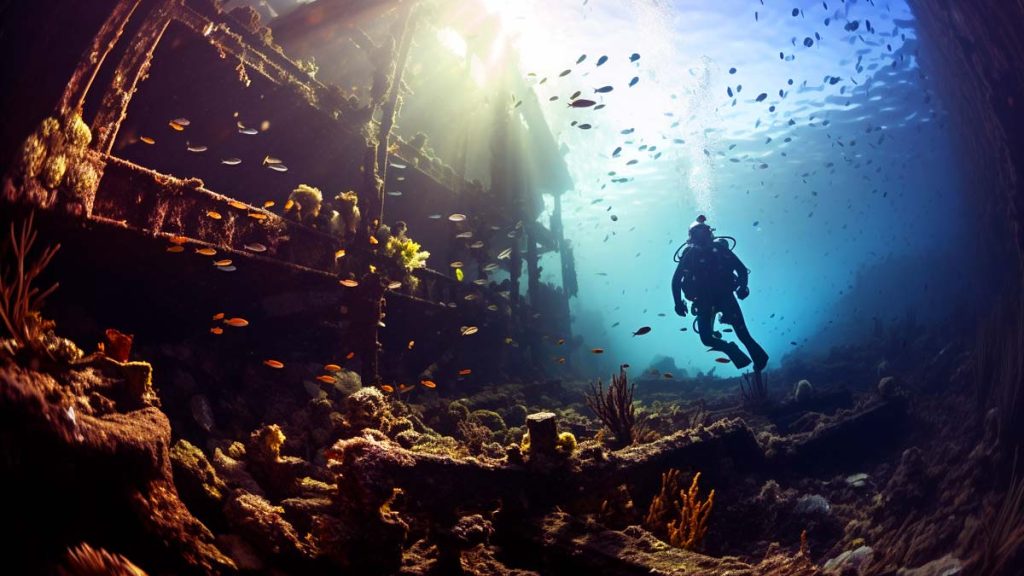
Untold secrets loom in the cerulean waters of the Pacific Ocean in Southern California. Wreck Alley is particularly intriguing among San Diego’s oceanic mysteries because it’s a glorious testimony of how humankind and marine life can work in tandem to create a wonderland beyond imagining. But what is this massive underwater curiosity, exactly? How was it built, and by whom? How can you get access to the booming bounty of undersea life thriving in and around this artificial reef born from deliberately sunken ships? We’ve got answers.
Of course, there are loads of other things to do in America’s Finest City – both on land and in the water. From SeaWorld to Balboa Park, you’re options for entertainment are practically limitless!
What is Wreck Alley in San Diego?
Wreck Alley is a collection of superstructures that were intentionally plunged into the Pacific Ocean two miles west of Mission Beach. Under the instruction of marine experts – ships, barges, bridges, and platforms have been purposefully placed in varying depths and locations along Wreck Alley San Diego.
The result? An enchanting maritime graveyard that has resurrected new marine life in the depths of the ocean. It’s also resulted in artificial reefs that have grown to meteoric fame for primo scuba diving adventures. Most importantly, Wreck Alley has bloomed into a phenomenal ecological haven for spectacular marine biodiversity.
History of Wreck Alley
Concerned maritime experts and conservationists sank the first ship (El Rey) in 1987 after volunteers doggedly prepped and gutted it, making it suitable for optimal diving and marine life conditions. Since then, other ships and structures have been painstakingly cleaned and then scuttled underwater to bolster bio-tourism and biodiversity. The most recent addition to this watery realm is a Canadian navy ship, the HMCS Yukon, which was released to its 100-ft depth in 2000.
We’ll go into more detail about the sunken ships and structures in a minute. For now, we wanted to introduce you to some key players involved in the planning of this iconic artificial reef, which are:
- California Department of Fish & Game Artificial Reef Program
- San Diego Oceans Foundation
- San Diego Council of Diving Instructors
- U.S. Navy Demolition Team
- California Ships to Reefs (non-profit)
- California Coastal Commission
San Diego Wreck Alley is the largest collection of intentionally scuttled ships on the West Coast, proving to be a monumental success in its decade-long history. From crusty relics and oxidized giants, a swarm of underwater life has erupted and continues to prosper to this day. As one expert shark diving enthusiast, Nick LeBeouf, once said, “It’s like the structures changed from rusted hulks to an undersea garden.”

Key Attractions in Wreck Alley
Sure, diving in Wreck Alley offers glimpses of history but it also unveils exhilarating encounters with buzzing marine ecosystems flourishing amidst the wreckage. Each dive reveals new hidden treasures, and here are a few key attractions in Wreck Alley San Diego that make it a must-visit destination for sea lovers all over the world.
El Rey
As we briefly mentioned earlier, this is the first deliberately scuttled ship that started the Wreck Alley phenom. This 100-foot-long, 133-ton ship was intentionally and finally laid to rest in Wreck Alley on April 2nd, 1987, after working as a kelp-cutting vessel for 41 years. It now slumbers around 80 feet at the bottom of the Pacific.
Since its retirement into the sea, El Rey has attracted a bevy of marine beauties, such as strawberry anemones, schools of young barred sand bass, sea stars, spiny lobsters, and lemon dorids – just to name a few species.
The Ruby E
About a quarter mile north of El Rey is the second vessel to join the sleeping giants of Wreck Alley. This 165-foot US Coast Guard cutter was a working vessel from 1934 until it was finally retired to the artificial reef lineup in 1989. It stoically settles at a depth of around 80 feet and has become a mighty magnet for maritime flora and fauna not typically seen in other wreck sites.
When exploring The Ruby E, you can anticipate thrilling sights such as the (slightly scary-looking) lingcod fish and halibut darting throughout the vessel. You can also spy dazzlingly colored anthozoans on the ship’s hull and other invertebrates, such as nudibranchs and crabs.
The HMCS Yukon
Since it was enacted for service in the Royal Canadian Navy in 1963, this Mackenzie-class destroyer lived a colorful life as an escort for the QEII in the First Canadian Escort Squadron and eventually became an integral military training vessel until it was retired and purchased by the San Diego Oceans Foundation when it was purposefully plummeted into Wreck Alley in 2000.
The 366-ft Yukon destroyer is the newest to join the artificial reef fleet, and it’s also the most alluring because of certain dive optics like its wheelhouse, large forward guns, and whimsical dolphin cutouts on the sides of the ship.
A 60-100ft dive to the HMCS Yukon will reveal loads of marine life such as schools of sea bass and perch. If you’re lucky, you might catch a glimpse of leopard sharks, which are virtually harmless to divers. You can also eye-spy technicolored gorgonians and sea anemones.
The NOSC Tower
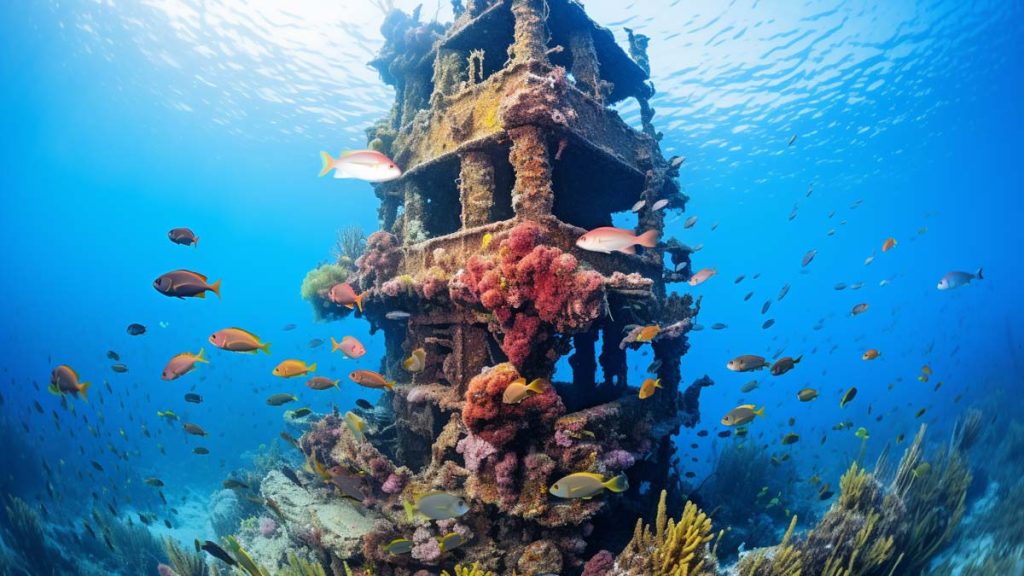
The Naval Ocean Systems Center (NOSC) Tower is unique in that it pretty much lived, died, and rose again as an artificial reef right where it stands. It wasn’t transported or plunked down into the water. Instead, it was built in 1959 and served as a monitoring structure and lookout for variations in temperature, currents, and changes in sea chemistry.
When El Nino tore through the area in the winter of 1988, the upper visible half of this 100 ft structure was blown to bits, essentially obliterating the topside of the tower. However, the lower half still stands resolute to this day and provides a home to a teeming array of marine life.
When you submerge yourself (at a depth of around 20 – 60 ft) to explore the NOSC Tower, you can expect to find it encrusted with countless mussels and scallops. Bass and blacksmith fish amble in and out of the tower supports too. You’ll also see vibrantly-colored sea stars, anemones, shrimps, and crabs.
Other Notable Wrecks
In addition to the previously mentioned optics, you can also check out other underwater features, such as the Old Ingraham Street Bridge, which was plopped into Wreck Alley in 1992. The concrete and rebar of the bridge remnants serve as a cozy spot for creatures like octopuses, eels, happy pink sea fans (gorgonians), and other reef fish. You might get lucky and even spot a great white shark while exploring the wreckage.
Here are a few other notable wrecks and underwater sites worth seeing:
- The Sewer Pipe is located on the south end of Wreck Alley and west of Point Loma.
- The Train Wheels about 1,000 feet offshore in Point Loma
- USS Hogan, a WWII-era destroyer, deliberately sunk in the Point Loma peninsula region on the Mexican border.
- Submerged P-38 lightning plane in waters off Torrey Pines about 18 minutes from La Jolla Cove
How Deep is Wreck Alley in San Diego?
Most of the expanse of Wreck Alley is positioned in what is called “recreational depths,” making it a prime spot for underwater explorers and divers. Depths of sites throughout the Alley range from anywhere between 20 to 130 feet below water surface level. Check out this list for more detailed depths on each site and difficulty levels for each:
| Dive Site | Depth | Diver Difficulty Level |
| El Ray | 60 – 80 ft | Advanced |
| Ruby E | 65 – 80 ft | Advanced |
| HMCS Yukon | 60 – 100 ft | Advanced (a penetration permit is required if you want to venture inside the wreck) |
| NOSC Tower | 20 – 60 ft | Open Water |
| Old Ingram Street Bridge | 50 – 70 ft | Mid to Advanced |
Diving in Wreck Alley
As you can see, most diving difficulty levels for Wreck Alley are advanced. So, unless you’re fully certified and experienced at scuba diving, you should look into going on a tour or getting property trained and outfitted before you go.
If you want to dive Wreck Alley in San Diego, we tapped Odyssea Diving for its expertise and professionalism. Their skilled instructors will expertly guide you through the wrecks safely while ensuring you have an unforgettable experience underwater. From beginner divers to seasoned pros, Odyssea Diving caters to all levels of expertise, making it the ideal choice for exploring Wreck Alley.
Be sure to check the weather and tide conditions before diving too. The Alley is located in the Mission Channel, which is typically pretty low-key and gets less turbulent than other dive sites. In terms of weather, winter and late fall are ideal, and August to October will give you the best optics as the water is usually clearer during these months. Early summer and spring can get tricky because the visibility might be murky with occasional algae blooms.
How to Prepare for a Dive in Wreck Alley
You know what they say – proper preparation prevents poor performance. So, before you go a’wrecking, check out our prep list:
- Make sure your diving certification is up to date and that you have the necessary experience for wreck diving.
- Study a Wreck Alley San Diego map or talk to a guide beforehand to familiarize yourself with the layout of the wrecks you plan to explore.
- Pack all essential diving gear, including a reliable mask, fins, regulator, buoyancy control device (BCD), and appropriate exposure protection for the water temperature.
- Double-check your equipment to ensure everything is in working order before heading out.
- Consider booking your dive with a reputable diving center like Odyssea Diving in San Diego that offers experienced guides familiar with Wreck Alley’s underwater terrain.
- Communicate any specific preferences or concerns you may have prior to the dive so they can tailor the experience accordingly.
- Maintain good physical fitness leading up to your dive and stay hydrated to prevent any issues underwater.
When is Wreck Alley Open?
Wreck Alley is open to the public year-round, 7 days a week, 24 hours of day. Even better – you don’t have to worry about Wreck Alley San Diego prices, because it’s free to the public to dive. That said, the ideal time to go depends on your comfort level with water temperatures and visibility. Summer months tend to offer warmer waters, making it pleasant for extended dives. However, many divers also enjoy exploring these sunken ships during the cooler winter months when visibility can be at its best.
About Conservation and Preservation Efforts at Wreck Alley
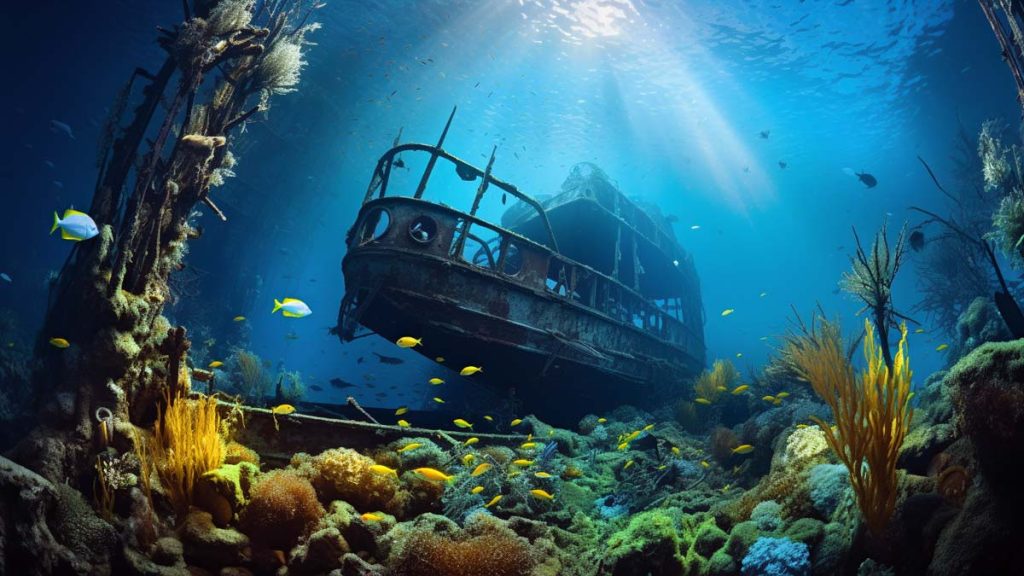
As you might expect, preserving the underwater ecosystem at Wreck Alley in San Diego is paramount for maintaining the beauty and integrity of this unique dive site. Conservation efforts are essential for safeguarding marine life, coral reefs, and historic wrecks that make up this underwater marvel.
Divers play a significant role in preserving Wreck Alley by following responsible diving practices such as not touching or taking anything from the wrecks, respecting marine life, and avoiding damaging delicate corals.
Think about linking up with local organizations which work diligently to raise awareness about the importance of conservation at Wreck Alley through educational programs, clean-up initiatives, and advocating for sustainable tourism practices among visitors.
Other Activities Near Wreck Alley in San Diego
When you’ve had your fill of exploring the underwater wonders of Wreck Alley, there’s still plenty more to experience in the vibrant aquatic playground that is San Diego.
For those of you looking for a more relaxed water adventure, snorkeling is a fantastic option near Wreck Alley. Slip into the crystal-clear waters and ogle the colorful marine life that surrounds you. Kayaking and other low-key water activities in La Jolla Cove are another popular choice for soaking up the sun while getting some exercise in the tranquil waters of San Diego.
If you prefer staying dry but still want to enjoy the beauty of Wreck Alley from above, consider taking part in various water activities such as paddleboarding or sailing. No matter what your preference, there’s something for everyone near Wreck Alley in San Diego!
Ready, Set, Dive!
Wreck Alley in San Diego is more than a wicked-awesome diving spot – it’s a kingdom of marine biodiversity. We hope this ultimate guide on exploring the Alley inspires you to go treasure hunting of a different kind – the kind where you spot the brilliant gems of the Pacific against the backdrop of incomparable ruins. Whether you’re looking to collect mental snapshots of a rare great white shark sighting or want to take underwater pictures of the unparalleled, eerie beauty of giant relics submerged in the sea – diving into the bodacious abyss of Wreck Alley will not disappoint.
Say you’re not up to plunging into the great depths? Not a problem. San Diego is a playground for adults and kids alike – and you don’t even have to step into the water if you don’t want to. Check out these sensational attractions you’re gonna love to visit in SD.

About the author: Avia is an avid nature-lover, published author, and owner of several websites she’s developed over the last 20 years. Her love and knowledge of Southern California blossom from a decades-long tradition of visiting the area with her family during winter vacations. When she’s not writing, Avia can be found kanoodling with her crushingly cute canines.
Media credits: Unless otherwise noted, the conceptual images of diving in Wreck Alley San Diego in this article are copyright of LaJolla.com







